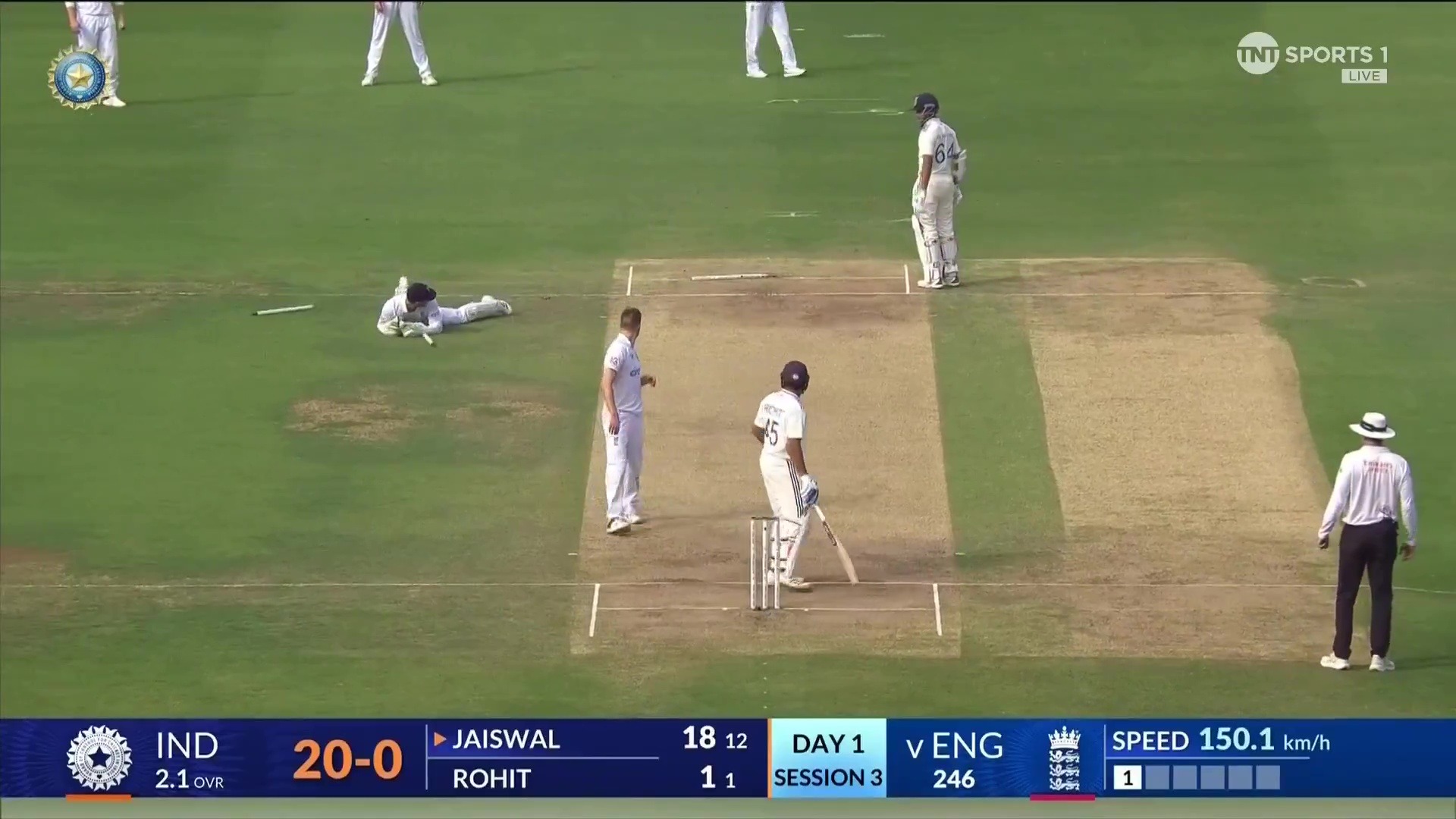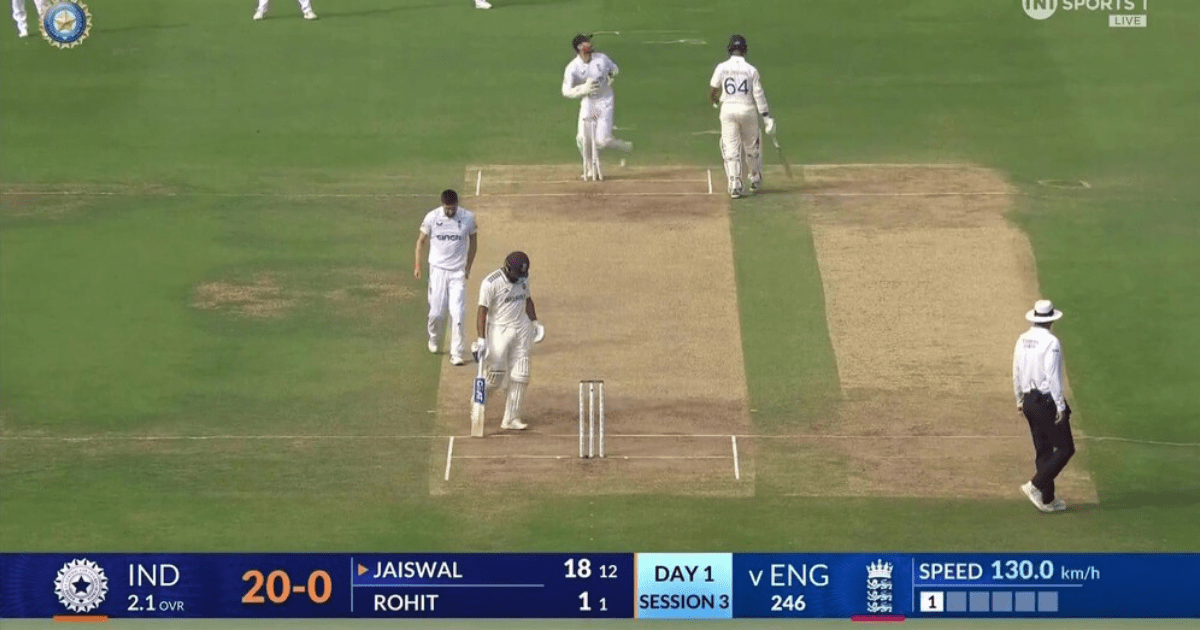England's first day of their tour of India got off to a comedic start as wicketkeeper Ben Foakes tripped over the stumps during India's innings. The incident happened after the ball was returned to the wickets by Ollie Pope, and Foakes lost his bearings as he chased after it. The result? A hilarious tumble that left Foakes and his teammates in fits of laughter. Fans couldn't help but join in the amusement, with one saying, "We've reached peak banter phase again, bring 'em home." Another joked, "Surely worth an appeal."
A Day of Ups and Downs
The stumble over the stumps seemed to perfectly encapsulate England's day against India. While skipper Ben Stokes top scored with 70, the team was all out for 246. In response, India came out swinging, with opener Yashasvi Jaiswal racing to an unbeaten 76 and terrorizing England debutant Tom Hartley. The hosts finished the day on 119-1, trailing by 127 runs.
Fans Find the Funny Side
Fans on social media couldn't get enough of Foakes' stumble, finding it to be the highlight of the day. One fan said, "Ben Foakes falling over the stumps was probably the highlight today." Another fan defended Foakes, saying, "In his defense, three large white pieces of wood sticking out the ground can be hard to spot."
It was a day of laughter and lightheartedness for England, despite the challenges they faced on the cricket field. But as they say, sometimes you just have to laugh it off and move on to the next day.

Frequently Asked Questions
How many times a week do professional cricketers train for their games?
The schedules of professional cricketers are intense during the series and tournaments, as well as in the run-up to the season. For most of the year, they train about five to six times per week, focusing on different aspects of the game, including physical fitness, skills training, and match practice. In the offseason, players may train less frequently or with less intensity. This allows them to rest and improve their skills or address specific areas of play.
Are there specific recovery protocols that professional cricketers follow post-training or match?
To ensure their optimal physical state, professional cricketers adhere to specific recovery protocol after training and games. These protocols include cooldown exercises, stretching sessions to alleviate muscle tension, and ice baths or cryotherapy to reduce inflammation and muscle soreness. The importance of proper nutrition, hydration and protein intake in muscle repair is stressed. Along with physiotherapy treatment, such as foam rolling, massage and rehabilitative exercises specific to injury, adequate sleep is also encouraged. To manage workloads and prevent injuries, comprehensive recovery regimes are necessary.
What is the role of fielding exercises in a player’s routine?
Fielding drills should be a part of every cricketer’s routine. In the modern game, fielding is a very important skill. Good fielding can make or break a match by saving runs, making incredible catches or even causing a game-changing out. Fielding drills focus on improving agility, catching, throwing accuracy, and developing quick reflexes. Regular practice helps fielders to be sharp and responsive in the field, which not only boosts the team’s defensive capabilities but can also contribute significantly to the team’s morale and momentum.
How is training different for fast bowlers as compared to spinners?
The training requirements for fast and spin bowlers are very different. Fast bowlers focus on developing strength, speed, and endurance, with particular emphasis on aerobic and strength exercises that enhance the ability to bowl quickly and sustain energy levels throughout the day. Conversely, spin bowlers concentrate more on the technical aspects of their craft, such as variations in grip, wrist position, and delivery stride, along with tactical game play to outthink the batsman. Both types of bowlers work extensively on accuracy and consistency in hitting specific lengths.
What is an average training program for a professional Cricketer?
A professional cricketer’s training plan is well-structured and aims to improve physical fitness and technical skill. The schedule usually includes morning workouts that include cardiovascular exercises and agility drills. In general, the afternoons are reserved for skills-specific training like batting, fielding and bowling. Cricketers also practice simulated matches to prepare them for the real game, as well as regular net sessions. Rest and recovery also form part of the program, with special attention being paid to adequate rest and physiotherapy as needed.
Statistics
- Post-match recovery protocols, including active recovery and physiotherapy, can reduce injury recuperation times by up to 30% for professional cricketers.
- High-intensity interval training (HIIT) sessions, which are regularly included in cricketers’ fitness regimes, can increase their oxygen consumption by approximately 5-10%.
- Professional cricketers playing at the international level may engage in upward of 200 hours of net practice sessions in a year.
- A typical professional cricketer may spend up to 12-15% of their training time on mental skills, such as visualization and cognitive exercises.
- Spin bowlers spend an estimated 50-60% more time honing their technique in the nets compared to fast bowlers, who focus more on physical conditioning.
External Links
prodirectcricket.com
thecricketmonthly.com
wisden.com
lords.org
cricket.com.au
How To
Cricket Professionals: Nutritional Optimization
Cricket professionals should follow a healthy diet plan to maintain their busy training schedules. Work with a nutritionist to develop a diet rich in complex carbs for energy, proteins for muscle repair and healthy fats for durability. Players should drink fluids throughout the day including during training sessions and matches. Remember to adjust the dietary intake based on active and rest days to align with the body’s changing caloric demands. Planning pre-and post-training meals will help maintain energy and promote muscle recovery.
Did you miss our previous article…
https://www.sportingexcitement.com/cricket/major-change-in-sports-coverage-as-dazns-uk-tv-deal-for-indian-premier-league-hangs-in-the-balance/

